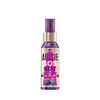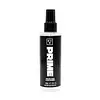What's inside
What's inside
 Key Ingredients
Key Ingredients

 Benefits
Benefits

 Concerns
Concerns

 Ingredients Side-by-side
Ingredients Side-by-side

Water
Skin ConditioningGlycerin
HumectantPhenoxyethanol
PreservativeAmodimethicone
PPG-2 Methyl Ether
PerfumingPEG-40 Hydrogenated Castor Oil
EmulsifyingBenzyl Alcohol
PerfumingPolyquaternium-11
Parfum
MaskingPolysorbate 80
EmulsifyingDisodium EDTA
Ethylhexylglycerin
Skin ConditioningAminomethyl Propanol
BufferingCitric Acid
BufferingLimonene
PerfumingTrideceth-12
EmulsifyingCetrimonium Chloride
AntimicrobialLinalool
PerfumingSodium Benzoate
MaskingCaprylyl Glycol
EmollientGeraniol
PerfumingCitral
PerfumingTasmannia Lanceolata Leaf Extract
Skin ConditioningTocopherol
AntioxidantWater, Glycerin, Phenoxyethanol, Amodimethicone, PPG-2 Methyl Ether, PEG-40 Hydrogenated Castor Oil, Benzyl Alcohol, Polyquaternium-11, Parfum, Polysorbate 80, Disodium EDTA, Ethylhexylglycerin, Aminomethyl Propanol, Citric Acid, Limonene, Trideceth-12, Cetrimonium Chloride, Linalool, Sodium Benzoate, Caprylyl Glycol, Geraniol, Citral, Tasmannia Lanceolata Leaf Extract, Tocopherol
Water
Skin ConditioningPolysorbate 80
EmulsifyingPropanediol
SolventPPG-5-Ceteth-20
EmulsifyingAloe Barbadensis Leaf Juice
Skin ConditioningBHT
AntioxidantButyl Methoxydibenzoylmethane
UV AbsorberCetrimonium Chloride
AntimicrobialCitric Acid
BufferingDimethicone Pg-Diethylmonium Chloride
Dipropylene Glycol
HumectantDisodium EDTA
Ethylhexyl Methoxycinnamate
UV AbsorberEthylhexyl Salicylate
UV AbsorberEthylhexylglycerin
Skin ConditioningCitrus Aurantium Bergamia Peel Oil
Juniperus Virginiana Oil
MaskingCoriandrum Sativum Fruit Oil
MaskingCitrus Limon Peel Oil
MaskingLemongrass Oil
Citrus Aurantium Amara Flower Oil
MaskingCitrus Aurantium Dulcis Peel Oil
MaskingCitrus Aurantium Amara Leaf/Twig Oil
MaskingMentha Viridis Leaf Oil
AstringentGlycerin
HumectantPEG-12 Dimethicone
Skin ConditioningPEG-40 Hydrogenated Castor Oil
EmulsifyingPhenoxyethanol
PreservativePolyquaternium-10
Polyquaternium-70
PPG-26-Buteth-26
Skin ConditioningQuaternium-80
Silicone Quaternium-8
Sodium Hydroxide
BufferingTrideceth-10
CleansingLimonene
PerfumingLinalool
PerfumingHexyl Cinnamal
PerfumingCitral
PerfumingGeraniol
PerfumingWater, Polysorbate 80, Propanediol, PPG-5-Ceteth-20, Aloe Barbadensis Leaf Juice, BHT, Butyl Methoxydibenzoylmethane, Cetrimonium Chloride, Citric Acid, Dimethicone Pg-Diethylmonium Chloride, Dipropylene Glycol, Disodium EDTA, Ethylhexyl Methoxycinnamate, Ethylhexyl Salicylate, Ethylhexylglycerin, Citrus Aurantium Bergamia Peel Oil, Juniperus Virginiana Oil, Coriandrum Sativum Fruit Oil, Citrus Limon Peel Oil, Lemongrass Oil, Citrus Aurantium Amara Flower Oil, Citrus Aurantium Dulcis Peel Oil, Citrus Aurantium Amara Leaf/Twig Oil, Mentha Viridis Leaf Oil, Glycerin, PEG-12 Dimethicone, PEG-40 Hydrogenated Castor Oil, Phenoxyethanol, Polyquaternium-10, Polyquaternium-70, PPG-26-Buteth-26, Quaternium-80, Silicone Quaternium-8, Sodium Hydroxide, Trideceth-10, Limonene, Linalool, Hexyl Cinnamal, Citral, Geraniol
Ingredients Explained
These ingredients are found in both products.
Ingredients higher up in an ingredient list are typically present in a larger amount.
This ingredient is a preservative, antimicrobial, and emulsifier. It is often used in cosmetics for its ability to cleanse, condition, and reduce static.
Cetrimonium chloride is a quaternary ammonium salt, meaning it has a water-soluble structure.
Citral is a fragrance and used to add a lemon-like scent to products. It is both naturally found in plants and created synthetically. In plants, it is commonly occurring in lemon myrtle, lemongrass, lemon tea-tree, lemon verbena, and other citruses.
The EU mandates Citral be listed separately as a fragrance. It is a known allergen and may cause contact dermatitis. Citral can also used as a masking ingredient.
The term 'fragrance' is not regulated in many countries. In many cases, it is up to the brand to define this term. For instance, many brands choose to label themselves as "fragrance-free" because they are not using synthetic fragrances. However, their products may still contain ingredients such as essential oils that are considered a fragrance.
The term 'citral' is a collective term for two geometric isomers: geranial/Citral A and neral/Citral B.
Learn more about CitralCitric Acid is an alpha hydroxy acid (AHA) naturally found in citrus fruits like oranges, lemons, and limes.
Like other AHAs, citric acid can exfoliate skin by breaking down the bonds that hold dead skin cells together. This helps reveal smoother and brighter skin underneath.
However, this exfoliating effect only happens at high concentrations (20%) which can be hard to find in cosmetic products.
Due to this, citric acid is usually included in small amounts as a pH adjuster. This helps keep products slightly more acidic and compatible with skin's natural pH.
In skincare formulas, citric acid can:
While it can provide some skin benefits, research shows lactic acid and glycolic acid are generally more effective and less irritating exfoliants.
Most citric acid used in skincare today is made by fermenting sugars (usually from molasses). This synthetic version is identical to the natural citrus form but easier to stabilize and use in formulations.
Read more about some other popular AHA's here:
Learn more about Citric AcidDisodium EDTA plays a role in making products more stable by aiding other preservatives.
It is a chelating agent, meaning it neutralizes metal ions that may be found in a product.
Disodium EDTA is a salt of edetic acid and is found to be safe in cosmetic ingredients.
Learn more about Disodium EDTAEthylhexylglycerin (we can't pronounce this either) is commonly used as a preservative and skin softener. It is derived from glyceryl.
You might see Ethylhexylglycerin often paired with other preservatives such as phenoxyethanol. Ethylhexylglycerin has been found to increase the effectiveness of these other preservatives.
Geraniol is used to add fragrance/parfum to a product. It is the main component of citronellol. It is a monoterpenoid and an alcohol.
Monoterpenes are naturally found in many parts of different plants.
Geraniol can be found in many essential oils including Rose Oil and Citronella Oil. The scent of Geraniol is often described as "rose-like". Many foods also contain Geraniol for fruit flavoring.
Geraniol can irritate the skin when exposed to air. However, irritation depends on the ability of geraniol to penetrate into the skin. In general, geraniol is not able to penetrate skin easily.
Geraniol is colorless and has low water-solubility. However, it is soluble in common organic solvents.
Like citronellol, it is a natural insect repellent.
2,6-Octadien-1-ol, 3,7-dimethyl-, (2E)-
Learn more about GeraniolGlycerin is already naturally found in your skin. It helps moisturize and protect your skin.
A study from 2016 found glycerin to be more effective as a humectant than AHAs and hyaluronic acid.
As a humectant, it helps the skin stay hydrated by pulling moisture to your skin. The low molecular weight of glycerin allows it to pull moisture into the deeper layers of your skin.
Hydrated skin improves your skin barrier; Your skin barrier helps protect against irritants and bacteria.
Glycerin has also been found to have antimicrobial and antiviral properties. Due to these properties, glycerin is often used in wound and burn treatments.
In cosmetics, glycerin is usually derived from plants such as soybean or palm. However, it can also be sourced from animals, such as tallow or animal fat.
This ingredient is organic, colorless, odorless, and non-toxic.
Glycerin is the name for this ingredient in American English. British English uses Glycerol/Glycerine.
Learn more about GlycerinLimonene is a fragrance that adds scent and taste to a formulation.
It's found in the peel oil of citrus fruits and other plants such as lavender and eucalyptus. The scent of limonene is generally described as "sweet citrus".
Limonene acts as an antioxidant, meaning it helps neutralize free radicals.
When exposed to air, oxidized limonene may sensitize the skin. Because of this, limonene is often avoided by people with sensitive skin.
The term 'fragrance' is not regulated in many countries. In many cases, it is up to the brand to define this term. For instance, many brands choose to label themselves as "fragrance-free" because they are not using synthetic fragrances. However, their products may still contain ingredients such as essential oils that are considered a fragrance.
Learn more about LimoneneLinalool is a fragrance and helps add scent to products. It's derived from common plants such as cinnamon, mint, citrus, and lavender.
Like Limonene, this ingredient oxidizes when exposed to air. Oxidized linalool can cause allergies and skin sensitivity.
This ingredient has a scent that is floral, spicy tropical, and citrus-like.
Learn more about LinaloolPeg-40 Hydrogenated Castor Oil is derived from castor oil and polyethylene glycol (PEG). It is used as a emollient and emulsifier.
As an emulsifier, it helps prevent ingredients from separating. It also helps make the other ingredients more soluble; it is often used to solubilize fragrances. This increases spreadability and elongates shelf life in a product.
Emollients help soothe and soften the skin. They do this by creating a protective film on your skin. This barrier helps trap moisture and keeps your skin hydrated. Emollients may be effective at treating dry or itchy skin.
This ingredient may or may not be vegan, depending on the source.
Peg-40 Hydrogenated Castor Oil may not be fungal-acne safe. We recommend speaking with a professional if you have any questions or concerns.
Learn more about PEG-40 Hydrogenated Castor OilPhenoxyethanol is a preservative that has germicide, antimicrobial, and aromatic properties. Studies show that phenoxyethanol can prevent microbial growth. By itself, it has a scent that is similar to that of a rose.
It's often used in formulations along with Caprylyl Glycol to preserve the shelf life of products.
Polysorbate 80 is a surfactant and emulsifier. It is used to keep ingredients together, and prevent oils and waters from separating.
It is made from polyethoxylated sorbitan and oleic acid. This ingredient can be found in cosmetics, foods, and medicine. It is water-soluble.
Polysorbate 80 may not be fungal acne safe.
Learn more about Polysorbate 80Water. It's the most common cosmetic ingredient of all. You'll usually see it at the top of ingredient lists, meaning that it makes up the largest part of the product.
So why is it so popular? Water most often acts as a solvent - this means that it helps dissolve other ingredients into the formulation.
You'll also recognize water as that liquid we all need to stay alive. If you see this, drink a glass of water. Stay hydrated!
Learn more about Water